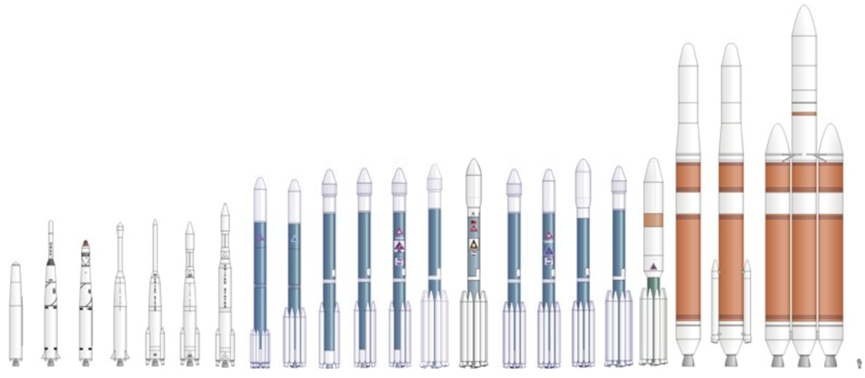Space Systems Command prepares to launch National Reconnaissance Office mission
- Satellite Evolution Group

- Jun 20, 2023
- 3 min read
Updated: Jun 23, 2023
The US Space Force’s Space Systems Command (SSC), the National Reconnaissance Office (NRO), and United Launch Alliance (ULA) are in final preparations to launch a classified satellite aboard a Delta IV Heavy rocket from Space Launch Complex (SLC)-37B at Cape Canaveral Space Force Station, Florida.
“Everything’s looking great and we’re on track to launch another vitally important national security capability into space,” said Maj. Gen. Stephen Purdy, program executive officer for Assured Access to Space. “This will be our third national security launch this year. We’ve worked alongside ULA to prepare this Delta IV Heavy, and in just a few days the team’s hard work will culminate in this highly anticipated launch. These launches place critical capabilities into orbit for our nation and our allies in what are dynamic times for the space community. Every member of our launch team understands what’s at stake and works with care and efficiency to prepare for what’s going to be a tremendous launch.”
To date, the NSSL has launched a total of 37 Delta IVs, comprised of 25 Mediums and 12 Heavy variants. NSSL Mediums began launching in 2006 and completed in 2019. NSSL has only two remaining Delta IV Heavy launches procured under the Launch Vehicle Production Services (LVPS) contract. Following this launch, the final Delta IV Heavy is projected to launch from CCSFS in 2024.
This is the first NSSL Delta IV Heavy launch in 2023 and the 13th NSSL Delta IV Heavy to date. Additionally, this will be the 10th Delta IV Heavy vehicle launched from CCSFS, Florida (two NASA and eight NSSL missions) for a total of 15 Delta IV Heavy vehicles successfully placed into orbit to date.

The history of the Delta family of launch vehicles date back to the late 1950s with the first launch of a Thor Delta in August of 1960. From there, in response to ever changing mission needs, the Delta evolved from a ballistic missile system into an extremely capable and versatile space launch platform. This process expanded the Delta’s payload capacity from a meager 100 lbs. delivered to an orbit of 115 miles up to a massive 62,550 lbs. (28,370 kg) delivered to low Earth orbit (LEO) or 30,450 lbs. (13,810 kg) delivered to Geostationary Transfer Orbit (GTO).
Over the 60+ years since 1960, there have been 12 Thor Delta (DM-19) launches, 43 launches of the three-stage A, B, C, D and E configurations, and 27 launches of the two-stage G, J, L, M, and N configurations. Next came the Delta I with 102 launches, followed by the prolific Delta II with the most launches of any Delta configuration at 152 launches. Delta III had three launches.
Finally, the Delta IV has a record of 29 launches of the Medium configuration, from 2002 to 2019 (25 NSSL, three NASA, and one commercial), and 15 launches of the Delta Heavy, including this launch of NROL-68. These various Delta vehicles have launched numerous payloads including military, government, and commercial weather, communications, and science satellites, robotic probes for exploration, eight Mars rovers, and one telescope, all of which have significantly contributed to our understanding of our planet, solar system, and universe beyond.
With this launch and one more Delta IV Heavy planned for 2024, the Space Force is approaching the end of the long and overwhelmingly successful era of Delta space launch vehicles.
NROL-68 will be the first of four missions for the Atlas V & Delta IV team over the final year of Atlas/Delta operations using a highly efficient, consolidated engineering approach. “I am very proud of the team’s focused dedication to our Delta and Atlas missions. The team performed extraordinarily well last year in the execution of their missions, and I expect this year will build upon those accomplishments," said Lt. Col. Scott Carstetter, Atlas V/Delta IV Materiel Leader.
Assured Access to Space acquires and executes launch services for the USSF, National Reconnaissance Office, and other agencies to reliably deliver on-orbit capabilities to the warfighter. AATS also conducts range operations for DoD, intelligence, civil, and commercial launches at Patrick Space Force Base, Florida and Vandenberg Space Force Base, California. AATS is executing transformative range and spaceport initiatives to meet unprecedented launch demands. AATS also leverages industry's on-orbit servicing, maneuvering, and debris removal innovations as it overseesUSSF Space Access, Mobility, and Logistics mission areas. AATS's 10,000 plus Guardians, Airmen, civilian, and contractor workforce spread across the nation are dedicated to mission success and assured access to space for our nation, partners, and allies.
Space Systems Command is the US Space Force’s field command responsible for acquiring and delivering resilient war fighting capabilities to protect our nation’s strategic advantage in and from space. SSC manages an $15 billion space acquisition budget for the DoD and works in partnership with joint forces, industry, government agencies, academic and allied organizations to accelerate innovation and outpace emerging threats. Our actions today are making the world a better space for tomorrow.



Comments